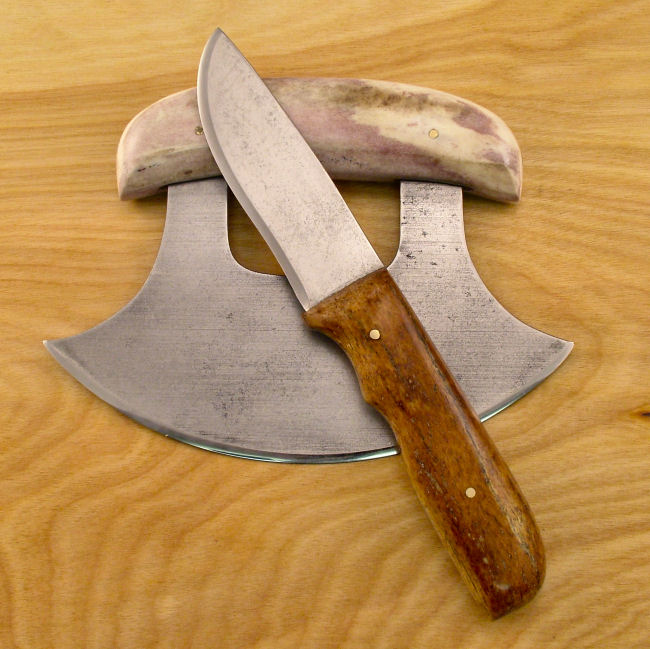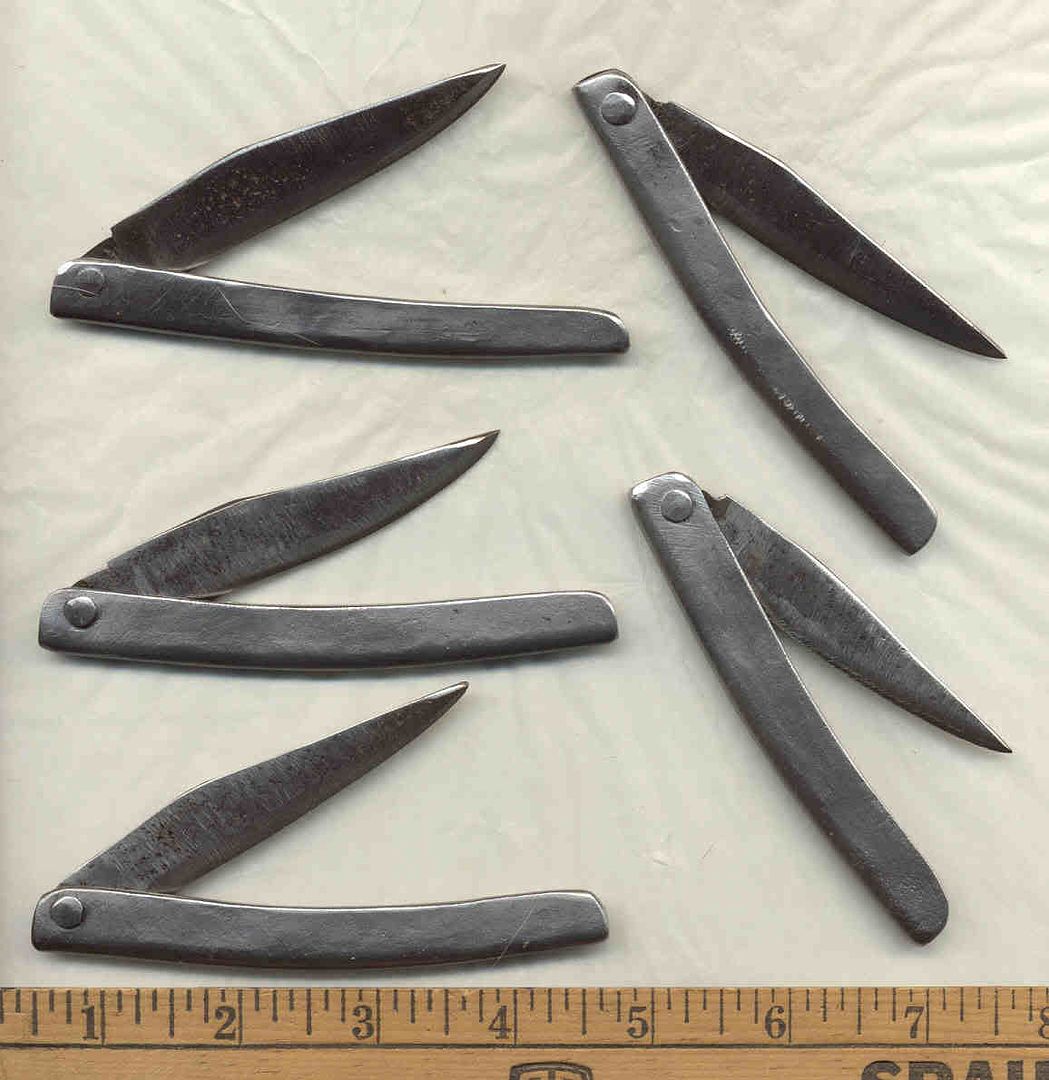Hey. I want to make a knife out of an old saw blade. I have experience with forging but don't have acess to one. Could I cut it out with a cold chisel? Any ideas would be much appreciated.
knife making
- Thread starter JoeSmo
- Start date
-
Hey Guest, Early bird pricing on the Summer Moot (29th July - 10th August) available until April 6th, we'd love you to come. PLEASE CLICK HERE to early bird price and get more information.
You are using an out of date browser. It may not display this or other websites correctly.
You should upgrade or use an alternative browser.
You should upgrade or use an alternative browser.
you could probaly use a cold chisle but it will go faxter an smoother with an angle grinder. just my .02 worth, i use a grinder to make all my knives as i dont have my forge built yet.
dean
dean
Hmm, bit of a quandry there Joe,
If you cut the blade cold it's likely to take ages, and if you do it hot (ie a grinder) it's likely that you'll need to heat treat the finished article.
I would consider the hot option as a first step into heat treatment of knife blades. Once you have ground the basic shape of your intended blade, heat it up to a good red heat. Any heat source will do, gas torch, open fire or even the backyard barbeque. Check the hot steel with a magnet - so that you know when it looses its attraction, then without delay, quench the blade in oil. Next step is to clean the blade up so you can see bare metal and heat it more gently this time till you see it turning a straw colour, then allow the blade to cool naturally - hey presto one hardened and tempered blade ready to be handled.
Good luck
Ogri the trog
If you cut the blade cold it's likely to take ages, and if you do it hot (ie a grinder) it's likely that you'll need to heat treat the finished article.
I would consider the hot option as a first step into heat treatment of knife blades. Once you have ground the basic shape of your intended blade, heat it up to a good red heat. Any heat source will do, gas torch, open fire or even the backyard barbeque. Check the hot steel with a magnet - so that you know when it looses its attraction, then without delay, quench the blade in oil. Next step is to clean the blade up so you can see bare metal and heat it more gently this time till you see it turning a straw colour, then allow the blade to cool naturally - hey presto one hardened and tempered blade ready to be handled.
Good luck
Ogri the trog
If you are going to be using a saw blade, then I can see no reason at all to go and do things that will mean that you will have to re-heat treat. That really would defeat the pupose of using pre-hardened and tempered steel. It would make more sense, be far less trouble, to go get annealled stock. You can do as Ogri says, but its going to be a lot of trouble, and while the saw will be properly hardned when you start, your mucking around with a gas torch and magnet will more than likely end up with a knife whose properties are not as good as the saw you started with.
So, what kind of saw is this? I am imagining it will either be one of the large reciprocating hacksaw blades, or a large circular saw, in order to get enough thickness to bother fooling with. Many modern saws have hardened inserts, or induction hardened teeth, and won't make very good knives. Its the old ones that are all at the same hardness that are good.
If you are playing with a giant hacksaw blade, grinding it won't really hurt it if it gets hot, these things are usually M2 HSS and are meant to get hot and retain their hardness. On other steels, do the inital grinding a bit over-size and then more carefully grind off the heat effected zone (HEZ).
So, what kind of saw is this? I am imagining it will either be one of the large reciprocating hacksaw blades, or a large circular saw, in order to get enough thickness to bother fooling with. Many modern saws have hardened inserts, or induction hardened teeth, and won't make very good knives. Its the old ones that are all at the same hardness that are good.
If you are playing with a giant hacksaw blade, grinding it won't really hurt it if it gets hot, these things are usually M2 HSS and are meant to get hot and retain their hardness. On other steels, do the inital grinding a bit over-size and then more carefully grind off the heat effected zone (HEZ).
These were made by Maynard Linder from old saw blades. They were never heat treated except for the original heat treat. Maynard cuts his blades using a metal shear (a Beverly shear). They hold a great edge but are easily sharpened.

If you want to do it with a cold chisel, I would check out the book Foxfire 4. In that book, Troy Danner makes a knife from a crosscut saw using a cold chisel to cut it out. This is a very commom way to make using knives the old timey way.

If you want to do it with a cold chisel, I would check out the book Foxfire 4. In that book, Troy Danner makes a knife from a crosscut saw using a cold chisel to cut it out. This is a very commom way to make using knives the old timey way.
Hey Joe,
Did you get your knife cut out and finished? How are you doing it?
Do you have any pics?
Did you get your knife cut out and finished? How are you doing it?
Do you have any pics?
I have made several dozen knife blades from hand saws and crosscut saws. I draw the shape I want on the saw blade, then carefully chisel a light line around that shape. I then go back along that outline several more times with the chisel. After you have chiseled in a bit, the steel in the saw blade will begin to crack/break along the line of your chiseling. Clamping the saw blade in your vise and lightly tapping along the side of the blade helps extend that crack/chisel line until your knife blade blank breaks free.
The edge will be rough, with lots of sharp jagged edges. I then carefully grind all along the outside of my knife blank to smooth and true up the steel to the final profile of the knife blade I want. I cool the saw steel often. If you can't hold/touch it with your fingers - cool it right now. This will retain the original heat-treat of the saw blade. Once I get the profile of the blade smoothed and trued up, I then start to grind in my edge bevels.
If you have very good (expensive) drill bits, you can drill the holes you need to attach your handle. But the hardened steel in the saw blades eats up drill bits fast. I now use a very small punch to "punch" my hole through, and then ream it out with my drill. You don't need to drill holes and pin your handle on - you can just glue it with good epoxy.
The blades in these iron-handled French styled clasp knives were made this way. The style is based on some original artifacts recovered from la Salle's ship la Belle which sank of the Texas coast in 1685.

These blades were made from a large two-man crosscut saw blade. I have made Penny Knife blades from a regular woodworking hand saw. But I use OLD saw blades. Some modern ones ony have good tool steel right along the teeth/cutting edge, and use mild low-carbon steel for the rest of the saw. If you don't overheat the metal when you are grinding it to shape, they hold an edge real well, and are pretty easy to resharpen.
Good luck on your project. It's always more fun and satisfying to use a tool you made yourself.
Just my humble thoughts to share.
yhs
Mike Ameling
The edge will be rough, with lots of sharp jagged edges. I then carefully grind all along the outside of my knife blank to smooth and true up the steel to the final profile of the knife blade I want. I cool the saw steel often. If you can't hold/touch it with your fingers - cool it right now. This will retain the original heat-treat of the saw blade. Once I get the profile of the blade smoothed and trued up, I then start to grind in my edge bevels.
If you have very good (expensive) drill bits, you can drill the holes you need to attach your handle. But the hardened steel in the saw blades eats up drill bits fast. I now use a very small punch to "punch" my hole through, and then ream it out with my drill. You don't need to drill holes and pin your handle on - you can just glue it with good epoxy.
The blades in these iron-handled French styled clasp knives were made this way. The style is based on some original artifacts recovered from la Salle's ship la Belle which sank of the Texas coast in 1685.

These blades were made from a large two-man crosscut saw blade. I have made Penny Knife blades from a regular woodworking hand saw. But I use OLD saw blades. Some modern ones ony have good tool steel right along the teeth/cutting edge, and use mild low-carbon steel for the rest of the saw. If you don't overheat the metal when you are grinding it to shape, they hold an edge real well, and are pretty easy to resharpen.
Good luck on your project. It's always more fun and satisfying to use a tool you made yourself.
Just my humble thoughts to share.
yhs
Mike Ameling
I recently received a dremel tool as a gift. I used that to cut out the blade but I think its too think to use as a knife.
How thick is it? What sort of saw did it come from? Anything up to 3 or 4mm wouldn't be out of the ordinary.
The problem with using the dremel to cut it out would be the heat generated by the cutting - this will remove the original heat treatment to an extent. I guess chiselling would be a cold process that wouldn't do that.
The problem with using the dremel to cut it out would be the heat generated by the cutting - this will remove the original heat treatment to an extent. I guess chiselling would be a cold process that wouldn't do that.
If you are not going to heat treat it you need to keep it cool as if it gets hot it will anneal and not hold an edge.
I've just found what I was looking for, check out this tutorial
http://www.primitiveways.com/pt-knives-1.html
http://www.primitiveways.com/pt-knives-1.html
Similar threads
- Replies
- 2
- Views
- 246
- Replies
- 20
- Views
- 884
- Replies
- 2
- Views
- 369
